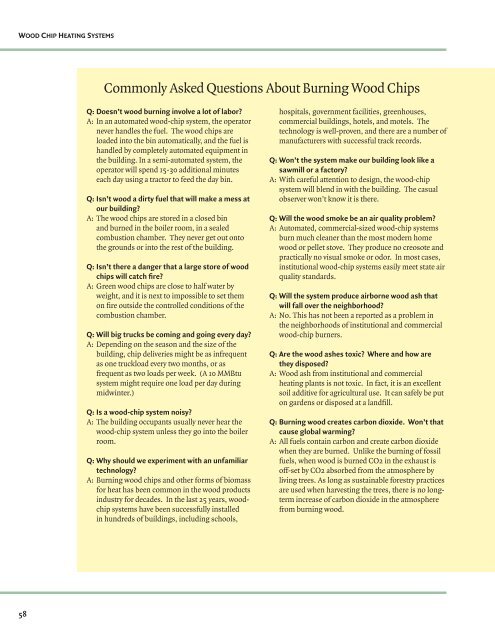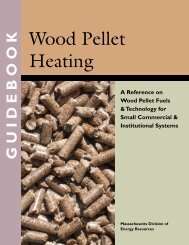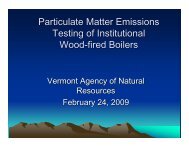Wood-Chip Heating Systems - Biomass Energy Resource Center
Wood-Chip Heating Systems - Biomass Energy Resource Center
Wood-Chip Heating Systems - Biomass Energy Resource Center
Create successful ePaper yourself
Turn your PDF publications into a flip-book with our unique Google optimized e-Paper software.
WOOD CHIP HEATING SYSTEMS<br />
58<br />
Commonly Asked Questions About Burning <strong>Wood</strong> <strong>Chip</strong>s<br />
Q: Doesn’t wood burning involve a lot of labor?<br />
A: In an automated wood-chip system, the operator<br />
never handles the fuel. The wood chips are<br />
loaded into the bin automatically, and the fuel is<br />
handled by completely automated equipment in<br />
the building. In a semi-automated system, the<br />
operator will spend 15-30 additional minutes<br />
each day using a tractor to feed the day bin.<br />
Q: Isn’t wood a dirty fuel that will make a mess at<br />
our building?<br />
A: The wood chips are stored in a closed bin<br />
and burned in the boiler room, in a sealed<br />
combustion chamber. They never get out onto<br />
the grounds or into the rest of the building.<br />
Q: Isn’t there a danger that a large store of wood<br />
chips will catch fi re?<br />
A: Green wood chips are close to half water by<br />
weight, and it is next to impossible to set them<br />
on fi re outside the controlled conditions of the<br />
combustion chamber.<br />
Q: Will big trucks be coming and going every day?<br />
A: Depending on the season and the size of the<br />
building, chip deliveries might be as infrequent<br />
as one truckload every two months, or as<br />
frequent as two loads per week. (A 10 MMBtu<br />
system might require one load per day during<br />
midwinter.)<br />
Q: Is a wood-chip system noisy?<br />
A: The building occupants usually never hear the<br />
wood-chip system unless they go into the boiler<br />
room.<br />
Q: Why should we experiment with an unfamiliar<br />
technology?<br />
A: Burning wood chips and other forms of biomass<br />
for heat has been common in the wood products<br />
industry for decades. In the last 25 years, woodchip<br />
systems have been successfully installed<br />
in hundreds of buildings, including schools,<br />
hospitals, government facilities, greenhouses,<br />
commercial buildings, hotels, and motels. The<br />
technology is well-proven, and there are a number of<br />
manufacturers with successful track records.<br />
Q: Won’t the system make our building look like a<br />
sawmill or a factory?<br />
A: With careful attention to design, the wood-chip<br />
system will blend in with the building. The casual<br />
observer won’t know it is there.<br />
Q: Will the wood smoke be an air quality problem?<br />
A: Automated, commercial-sized wood-chip systems<br />
burn much cleaner than the most modern home<br />
wood or pellet stove. They produce no creosote and<br />
practically no visual smoke or odor. In most cases,<br />
institutional wood-chip systems easily meet state air<br />
quality standards.<br />
Q: Will the system produce airborne wood ash that<br />
will fall over the neighborhood?<br />
A: No. This has not been a reported as a problem in<br />
the neighborhoods of institutional and commercial<br />
wood-chip burners.<br />
Q: Are the wood ashes toxic? Where and how are<br />
they disposed?<br />
A: <strong>Wood</strong> ash from institutional and commercial<br />
heating plants is not toxic. In fact, it is an excellent<br />
soil additive for agricultural use. It can safely be put<br />
on gardens or disposed at a landfi ll.<br />
Q: Burning wood creates carbon dioxide. Won’t that<br />
cause global warming?<br />
A: All fuels contain carbon and create carbon dioxide<br />
when they are burned. Unlike the burning of fossil<br />
fuels, when wood is burned CO2 in the exhaust is<br />
off-set by CO2 absorbed from the atmosphere by<br />
living trees. As long as sustainable forestry practices<br />
are used when harvesting the trees, there is no longterm<br />
increase of carbon dioxide in the atmosphere<br />
from burning wood.





